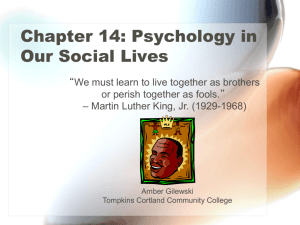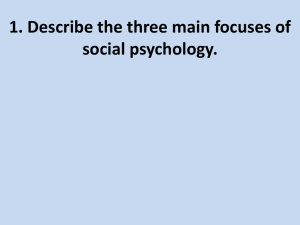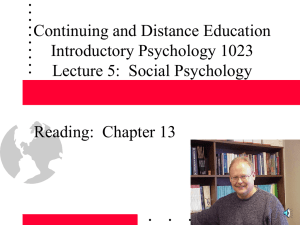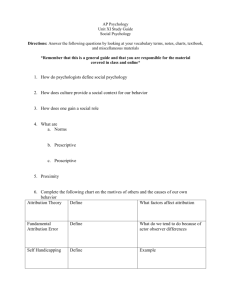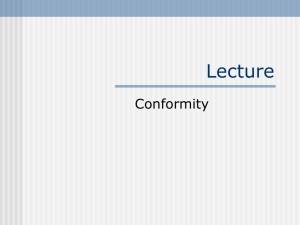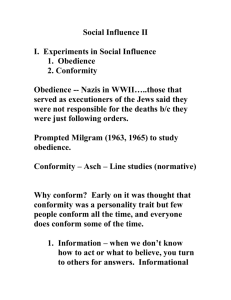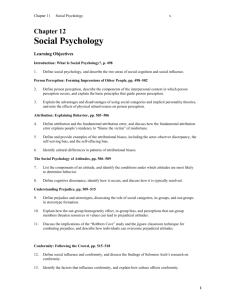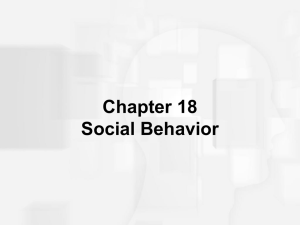Social Psychology Ch. 18 and 19
advertisement
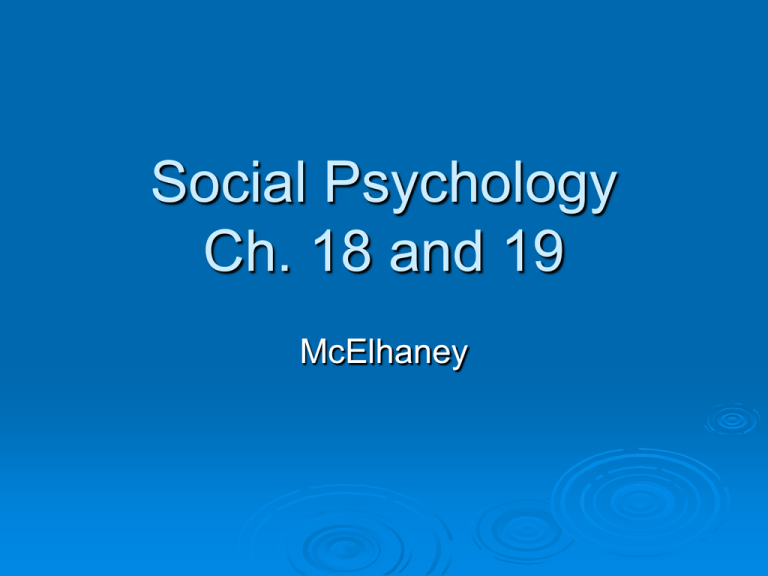
Social Psychology Ch. 18 and 19 McElhaney “Humans are social Animals” The Study of Human interaction Branch of Psych that analyzes how behavior is influenced by presence of others Studies how we behave, think, feel in Social Situations. Based on the concept of an Attribute: the cause of behavior Groups Influence our Behavior Culture = ongoing pattern of life that is passed from one generation to another. Components of Culture include: Language, marriage customs, concepts of ownership, sex roles Roles We all hold social roles – Positions in the structure of a group – Patterns of behavior expected of persons in various social positions Roles: Mother Boss Roles are Ascribedassigned to a person not under a person’s control Student Each has different expectations or sets of behavior. Achieved Roles= the opposite of assigned roles Voluntary roles Attained by special effort – Spouse – Teacher – Scientist Zimbardo Study Stanford University Impact on social roles Inmates + guards Males in a simulated prison Prisoner roles Dejected Traumatized Passive Dehumanized Depressed Guard roles Commanding Insulting demeaning Found destructive roles- cause role behaviors They had assigned social roles“In only a few days, our guards became sadistic and our prisoners became depressed and showed signs of extreme stress.” Zimbardo Results Many destructive relationships have a source in Learned Roles. Role Conflicts Two or more roles make conflicting demands Coach and parent Clashing demands for work, family, school Group Structure and Cohesion Factors to Cohesion=closeness Degree of attraction among group members Commitment to remaining in group Cohesive groups: Sit/sand together Pay attention to one another Mutual Affection Behavior is coordinated Work better together Status A person’s social position in a group determines his or her status- or level of social power & importance. Higher status = privileges Higher status people are treated betterWell dressed Norms Unspoken rules or guidelines Are an accepted standard for appropriate behavior for a specific group Lax norms cause lax behavior Social Influence A person’s behavior influences another. A convergence of beliefs, attitudes = change in behavior What motivates us to join a group? “Desires for Self-evaluation Self-protection Self-enhancement Influence Are motives for associating with others which group we join. Affiliation-basic principle Basic human trait A desire to associate with other people Connected to needs of: Approval, support, friendship, information Helps We alleviate – fear and anxiety prefer to be with people in similar circumstances Behavior of Groups: Group Membership Festinger said group membership fills need for: Social Comparison- standard to judge yourself Comparing your own actions, feelings, opinions, abilities… Must be compared to people of similar background, abilities, circumstances Downward Comparison: Comparison- for selfenhancement- self protection Comparing to someone who ranks lower Upward Comparison: Comparison with people of higher status- for self improvement Social Relationships Interpersonal Attraction= affinity to another person Is the basis for most voluntary social relationships Factors that Influence Attraction Physical proximity Physical attractiveness Halo Effect- tendency to generalize favorable impression to personal characteristics • Attractive people have perceived likeable characteristics Beauty vs. Personality = Which works best? (page 675) Competence- we are attracted to talented people Similarity-age, sex, race, background, interests, attitudes, beliefs Relationships Self-Disclosure Over Disclosure Reciprocity Gendered Friendships Personal Space and Proxemics Too close = discomfort Social Perception and Attribution Attribution= is a cause for behavior Attribute- (verb) place cause through observation of others Inferences/judgments about causes of behavior Attributional Theory We tend to ascribe or attribute causes of behavior to: External causes: outside a person Internal causes: inside a person What should one consider when making attributions? Factors of Attribution Actor: Who is it? Object: What is action directed towards? Setting: Social or physical environment Consistency: little changes on multiple occasions Distinctiveness: Behavior that occurs under specific circumstances. Factor of Attribution: Situational Demands SD = pressures to behave in certain ways in particular settings and social situations The “situation demands certain behavior” Discount: Downgrade or disregard internal causation when specific External causes are clear… Consensus- agreement, when an attribution is associated to many people- external causes Errors in Attribution Fundamental Attribution Error: to wrongly attribute actions of others to internal causes We have a tendency to think actions of others are caused by internal forces Actor-Observer Bias: (I vs. They) As actors- we find external explanations for our own behavior. As observers- we attribute behavior of others’ wants, motives and personality traits Social Exchange Theory “How profitable is the relationship?” Exchanges of attention, info, affection, favors Says: we all consciously weigh social rewards and costs Relationships must be profitable to participants: Rewards vs costs Fun vs Self Esteem Love and Liking Factors Romantic Attraction: Interpersonal attraction + emotional arousal Love = combinations Intimacy, passion, commitment and sexual desire Lovers Helps see partners in idealized ways create the relationship they wish for. Love and Attachment Child care-giving attachments have impact on adult attachments We use early attachments as mental models (We become what we learn) Secure Avoidant Ambivalent- Attachments Secure Attachment (59%) = friendly, good natured, likeable See others as well intentioned, reliable, trustworthy Generally not worried about being abandoned Avoidant Attachment (25%): Fear of intimacy, tend to resist commitment Pull back when things don’t go well Suspicious, aloof, skeptical Have difficulty trusting Get nervous when people get too close emotionally Ambivalent Attachment Mixed emotions and Conflicting feelings Affection, anger, emotional turmoil, physical attraction, doubt Self regard- misunderstood, unappreciated See others- unreliable, unable or unwilling to commit to lasting relationships Worry- partners don’t really love them or may leave, they want to be close but have doubts Evolution and Mate Selection: Men Evolutionary psych= study of evolutionary origins of behavior or patterns Patterns: Men are interested in casual sex Men prefer younger, more physically attractive partners Men are jealous over real or imagined infidelity Men look for reproductive capabilities, youth, health, beauty Evolution and Mate Selection: Women Prefer slightly older partners Industrious, high status, economic success Become upset by emotional infidelity more than sexual unfaithfulness Evolved Nurturing of young Interest in longevity of relationships Social Influences “Changes in behavior are induced by action of others.” Types of Social Influence: – Suggestion – Intensive Indoctrination – Group Pressure= Conformity – Obedience Group Pressure= Conformity People become aware of differences between themselves and actions, norms or values of others in group. Conformity= pressure for uniformity of members “Brings one’s own behavior into agreement with norms or the behavior of others” Norms= unspoken rules of conduct, normal or acceptable behavior Conformity Conformist- to not be considered strange or frightening Conformity refers to an individual’s behavior that adheres to the behavior pattern of a particular group- that a person belongs to. Non-conformist- independent thinking Who Conforms? People with high needs for structure Anxious Low self esteem and low self confidence Concerned with approval Culture that emphasizes group cooperation Solomon Asch Studied conformity- found that people conform to the will of the group- “The Power of Conformity” Asch (1955) Social Pressure Summarize the Theoretical propositions Describe the method Summarize the results Significance of Study Factors that impact Conforming Behavior 1. 2. 3. 4. A. B. C. D. Social Support Attraction Size of Group SEX Group Factors in Conformity To enforce conformity= group sanctions Negative= ridicule, laughing, staring, social disapproval, rejection/exclusion Sanctions work only if the subject wants to be part of the group. Social Support- for Non-conformists Support for non-conformists- When someone agrees with non- conformist It encourages- resistance to conformity Attraction: More attraction to the group (Reference Group) -> the more likely you are to conform to behavior and attitudes of group. Size of the Group: The tendency to conform increases as the size of the group increases (6-7) Sex/Gender There is some evidence to suggest women are more likely to conform People conform when appropriate behavior is unclear. Culture impacts conformity Collectivist Countries: Goals of the group in relation to goals of the individual. What is Group Think? Phenomenon of group behavior: People want to maintain approvaleven if decisions are bad. Authority- group members hesitate to question authority They think as a group instead of thinking about outcomes independently To Prevent Group Think: Define group roles Critical evaluator Stick to the facts-avoid bias Include “devils advocate” Group accountability Search for alternative solutions Re-evaluate important decisions When is it appropriate to resist authority?: Obedience Milgram Study: Obedience Study (1963) Yale University, “Obey at Any Cost” Subjects “gave” electric shocks to “learners” giving shocks. Milgram’s Ideas The tendency to obey is deeply ingrained. It cancels out a person’s ability to behave morally, ethically, and sympathetically. People have a tendency to obey people of authority- even if they violate their own codes of behavior. They would inflict pain on people if ordered to do so. Milgram Findings and Implications Distance to subject being shocked was a factor Closer to victim= less obedience Distance of Authority figure = direct relationship to obedience Farther away = less obedience When orders come from authority figurespeople rationalize that they are not responsible. **A personal act of courage or moral fortitude by one or two members of a group may free others to obey- unjust authority. Compliance One person bends to the authority of another person who has little authority Pressure people to comply- affects everyday Compliance and Sales Pressure Foot in the Door: a person who first agrees to a small request- will more likely comply with a larger demand Door in the face: With the idea of refusing a large request is a tendency to comply with a smaller request. Low Ball: get the person to commit to an act, then make terms of acting less desirable Passive Compliance Quietly bending to unreasonable demands or unacceptable conditions People have a tendency to avoid confrontation Ignore- personal insults, rebuffs, sacrifices of dignity “Not Practicing What you Preach” By LaPiere (1934) on Attitudes 1. 2. 3. 4. Summarize the Theoretical propositions Describe the method Summarize the results Significance of Study Factors impacting consistency between attitudes and behavior A. B. C. D. E. Strength of Attitude Stability of attitude Relevance of attitude Salience of attitude Situational pressures LaPiereAttitude Thought and Action Factors impacting consistency between attitudes and behavior A. B. C. D. E. Strength of AttitudeStability of attitude Relevance of attitude Salience of attitude Situational pressures Social Pressures We are constantly under pressure to conform, obey, comply- We need to recognize and resist these pressures. Assertiveness Aggression Victimization Bystander Interaction “To Help or Not to Help” Darley and Latane (1968) Kitty Genovese Murder1. Summarize the Theoretical propositions 2. Describe the method 3. Summarize the results 4. Significance of Study Darley and Lantane: Kitty Genovese Murder Why didn’t more people help Kitty Genovese? Factors in Bystander Interaction Diffusion of Responsibility Social Influence Personal Responsibility Evaluation apprehension Fives Steps of Action Social Comparison Acquaintances and Bystander Effect Knowledge of Bystander Effect Darley and Lantane: Five Steps to Decision 1. 2. 3. 4. 5. Notice Need Personal Responsibility, Decision-cost benefit analysisTake action
